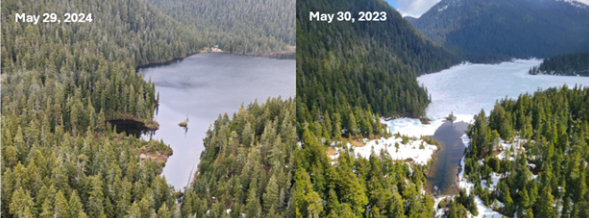Following up on news the previous week that the snowpack for the Chapman Water System is gone, Sunshine Coast Regional District (SCRD) general manager of infrastructure services Remko Rosenboom gave a water update to directors on June 13.
Snowpack
At the end of May last year, Chapman Lake was still mostly frozen, whereas this year, it was ice-free by the end of the month. There was still some snow in the upper watershed at the end of May, said Rosenboom but that too has declined rapidly.
The lack of snow is in line with the expectations given the year’s snowpack was down by half locally and around the province. Where in other places, the low snowpack increases risk of wildfires, the primary risk on the Coast is the loss of the spring water supply sooner.
The summer forecast for Canada, released a couple of weeks ago, predicts the Coast to be on the edge of normal temperatures (unlike the hot summer predicted to the East). Cooler temperatures help reduce evaporation in the watershed and keep water demand down, said Rosenboom. But, he stressed, the water system, especially in the summer, is rain-driven. “So we really need the rain to continue to fall over the summer, every now and then,” said Rosenboom. “And that’s hard to predict three months ahead.”
Moderate temperatures and rain in recent weeks have helped system supply but the Chapman Lake level is dropping and Stage 2 is likely in the next couple of weeks, said Rosenboom. (Stage 2 is triggered when water stops overflowing at the Chapman dam.) Once Stage 2 is called, the Chaster Well, the Church Road Well Field and Gray Creek will come online.
There are no concerns for any of the other water systems so far, said Rosenboom.
Later in conversation with directors, Rosenboom noted that in 2022, Stage 2 for Chapman wasn’t called until July 23, and that was the year of the drought emergency. “From that perspective, I never celebrate too early,” he said.
The siphons
Where there had been questions about siphons remaining at Chapman and Edwards Lakes past October (when the permits expire) shíshálh Nation will support the SCRD’s application to the province for the siphons’ continued use to 2025, said Rosenboom. “I foresee no problems province approving those permits,” he said.
The siphons may only be activated when the system reaches Stage 4 restrictions.
Environmental Flow Needs
The SCRD is still in ongoing “negotiations and discussions” with shíshálh Nation on “optimization” of environmental flow needs (EFN) for Chapman Creek, said Rosenboom. “We need an agreement in place with the Nation prior to us submitting an application to the province because they won’t consider an application without such arrangements in place with the Nation.”
The Nation and staff are aware time is of the essence, said Rosenboom, noting there’s no option to reduce the EFN once fish migration starts in August.
“So we’re still working with the Nation on the EFN, if not for this year, then for next year or the year after,” he said.
Gibsons area director Silas White asked to confirm that the application to the province was ready to go, noting that last year, public servants said there was information missing.
Rosenboom pointed to a longer investment in monitoring and discussions among the SCRD, province and Nation for 2025-2026 and possibly the longer term for EFN, of which the 2024 flow needs is a piece. For 2024, the province and staff have been in communication and the province is ready to review what they submit, Rosenboom indicated.
If the EFN were reduced by 40 litres per second in June and July and 20 litres a second in August, they would save about eight days of water in Stage 3, Rosenboom noted. Given that it’s already mid-June, even if they reach an agreement with the Nation and submit an application to the province, it may be mid-July before confirmation comes through. And at that point they would most likely need to hire a contractor to help with monitoring.
At this point, Rosenboom posits they may be able to delay Stage 3 by two or three days with a reduced EFN. “It’s still a couple of days, but there are other savings to be made that could result in a similar amount of days, like resolving some of those bigger leaks.”
Leaks
Leaks are a “big priority” for staff this summer, especially given the ongoing metering in Sechelt, said Rosenboom. Residences with “substantial” leaks will receive letters from the district every two months, with the goal of people fixing leaks and with the potential for water to be shut off should leaks not be resolved.
The SCRD also has a deal with the contractor installing Sechelt meters to report any major leaks identified during that process. In the past several weeks, the SCRD sent out seven shut-off notices, including two within Sechelt and one to a “large commercial operator on the Coast.” Six of those leaks have since been resolved.
Rosenboom estimates savings of 360,000 litres of water per day in fixed leaks.
The average amount of water needed per person on the Coast per day is about 490 litres, estimated Rosenboom. At a rough estimate, these leaks saved enough water for 720 houses, he said.
Also noted was about a sixth of the properties attached to SCRD water meters are subscribed to their water reports.



